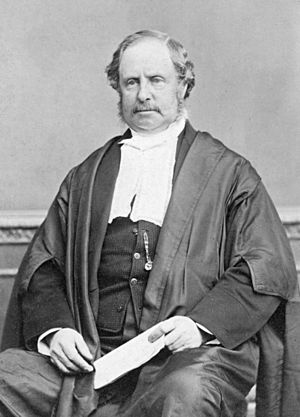David Monro facts for kids
Quick facts for kids
Sir David Monro
|
|
|---|---|

Sir David Monro, c. 1873
|
|
| 2nd Speaker of the House of Representatives | |
| In office 1861–1870 |
|
| Preceded by | Charles Clifford |
| Succeeded by | Dillon Bell |
| Personal details | |
| Born | 27 March 1813 Edinburgh, Scotland |
| Died | 15 February 1877 (aged 63) Nelson, New Zealand |
| Spouse | Dinah Secker |
| Relations | Alexander Monro (father) Alexander Monro (grandfather) Alexander Monro (great-grandfather) Charles Monro (son) James Hector (son-in-law) |
| Profession | Doctor, politician |
Sir David Monro (born March 27, 1813 – died February 15, 1877) was an important New Zealand politician. He is best known for being the Speaker of the New Zealand House of Representatives from 1861 to 1870. The Speaker is like the referee of Parliament, making sure debates are fair and follow the rules.
Contents
Growing Up and Moving to New Zealand
David Monro was born in Edinburgh, Scotland. His family had a long history of being doctors. His father, Alexander Monro, taught at the University of Edinburgh Medical School. David followed in their footsteps and became a doctor in 1835. He studied in big European cities like Paris, Berlin, and Vienna.
In 1841, David Monro decided to buy land in a new settlement called Nelson, in New Zealand. He moved there the next year. In 1845, he married Dinah Secker. They had seven children together. One of their sons, Charles Monro, later became famous for bringing the game of rugby union to New Zealand!
Starting a Political Career
David Monro quickly became involved in local issues. In 1843, after a conflict called the Wairau Affray, he was chosen to share the views of the Nelson settlers with the acting Governor. Because of his strong opinions, he was appointed to the Legislative Council in 1849. This was an early form of government in New Zealand. However, he resigned after a disagreement with the Governor, George Grey.
In 1853, David Monro was elected to the very first New Zealand Parliament. He represented the area of Waimea. He was re-elected for Waimea in 1858.
Becoming the Speaker
In 1861, David Monro was elected to Parliament again, this time for Picton. He was then chosen to be the Speaker. He was known for doing this job with dignity and fairness.
One time, in 1862, he used his special "casting vote" to decide a tie in Parliament. This vote helped remove William Fox from his role as Premier (like a Prime Minister). This decision was quite talked about at the time.
Monro continued as Speaker until 1870, when he decided to step down.
Later Political Years
After leaving the Speaker role, Monro tried to get back into Parliament in 1871 for the Motueka area. He was initially declared elected, but a special committee later said he hadn't won. Many people thought this decision was unfair and made for political reasons.
Even though he faced challenges, David Monro managed to get back into Parliament in 1872. He won a special election for the Waikouaiti area. He resigned from Parliament in 1873 after the government he opposed was defeated.
Life Outside Politics
David Monro lived in a beautiful house in Nelson called Warwick House, which was also known as Sunnyside. This house was built in 1854 and is a great example of early Victorian Gothic Revival style. It was a very large house, with about 50 rooms! Today, it is a protected historic building.
In 1866, David Monro was given the title of Knight, so he became Sir David Monro. He passed away at his home in Nelson on February 15, 1877.
A type of plant found only in New Zealand, called Myosotis monroi, was named after him.
See also
- Munro of Auchinbowie, a famous Scottish family that David Monro was connected to.
Images for kids


